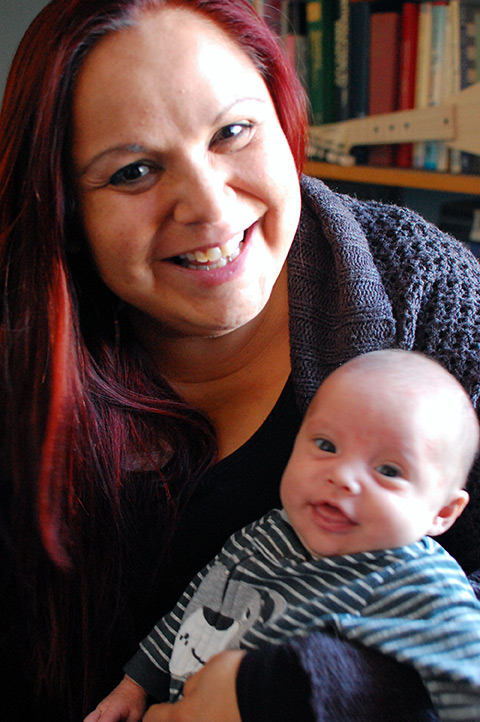Against the Odds
Inside a woman’s journey through pregnancy and dialysis
June 15, 2015

Meghan Kilner gave birth to a healthy baby boy at 37 weeks after months of intensive dialysis treatment. Leeland Allen Kilner Code was born on Jan. 18, 2015 at Sunnybrook’s DAN Women & Babies birthing unit. He weighed five pounds, 13 ounces.
Photo: Courtesy of Meghan Kilner
Meghan Kilner never thought she could get pregnant. Born with one kidney, Kilner became very sick when she was a toddler and doctors monitored her carefully with yearly ultrasounds while she was growing up. This was to ensure her kidney remained healthy and functioned well enough to filter all the waste and extra fluid in her body from her blood without the need for dialysis treatment.
Last summer, Kilner complained of feeling overcome by nausea, a common symptom associated with the early signs of pregnancy. It wasn’t until a checkup with her doctor for some routine blood work that she received confirmation of life-changing news.
“I actually really didn’t know how sick I was until I got pregnant. I thought I was perfectly healthy, but I found out my kidney was only working 13%, and I was very high risk [in terms of the pregnancy],” says Kilner, aged 35 years, from Toronto. “I never thought I could get pregnant, so getting pregnant was a blessing to me.”
That’s when Kilner’s obstetrician referred her to Dr. Michelle Hladunewich, a nephrologist and expert in the field of intensive dialysis treatment for women with kidney failure at Sunnybrook.
“Once you are pregnant, we need to intensify the dialysis so that we can get rid of all the toxins that come with being in renal failure, so that the baby can grow and thrive,” says Hladunewich, an associate scientist in the DAN Women & Babies Research Program at Sunnybrook Research Institute, and director of nephrology and obstetrical medicine at Sunnybrook.
Pregnancy for women on dialysis is associated with complications and can be dangerous for mother and baby. In some studies, the rate of pregnancy is less than 1% in women of childbearing age who are on dialysis.
To improve this figure, Hladunewich led a study comparing dialysis outcomes in pregnant women in Canada and the U.S. The results showed frequent and longer dialysis sessions dramatically improved pregnancy outcomes in women who want to become pregnant or who are already expecting, and led to significantly higher live birth rates. Read More Is Better for the full story.
Treatment dosage
Conventional dialysis is a total of 12 hours: three times a week for about four hours per day. Pregnant women are increased to 36 hours per week: at least six hours per day, six days a week, for nine months, says Hladunewich.
After weeks of appointments and tests, Kilner started dialysis treatments about four months into her pregnancy at Sunnybrook. She later moved to St. Joseph’s Health Centre in Toronto where she continued treatments because it was closer to home and work.
‘The beginning of dialysis was hard because my body wasn’t used to it. It was very tiring. The hardest thing was just being there for six hours. I would go from 7 a.m. to 2 p.m. It was pretty much a full-time job,” says Kilner about the daily routine that allowed her to catch up on her favourite TV shows and take a nap in-between. She also continued working a few shifts at the restaurant where she is a waitress.
Fast forward
At 37 weeks gestation, doctors at Sunnybrook’s DAN Women & Babies birthing unit induced labour in Kilner, who then endured more than 48 hours of labour before baby Leeland made his entrance into the world. On Jan. 18, 2015, Kilner gave birth to a healthy baby boy named Leeland Allen Kilner Code. He weighed five pounds, 13 ounces.
“I can’t stop kissing and looking at him. I’m just totally blessed,” she says about her first-born child, who is also grandchild number 20 for her parents. Kilner, who is adopted, is one of 13 children in her family.
Five months later, mommy and baby are happy and doing well. Kilner continues to receive conventional dialysis treatments, three times a week at a less intensive dosage, at St. Joseph’s Health Centre.
The next chapter
In May she received good news: “I’m on the donor list. Now, I’m just waiting to hear back from St. Michael’s Hospital [in Toronto] to see what the next step is,” she says. Kilner also joined the donor team for dragon boat racing at St. Joseph’s Health Centre.
Thanks to the Living Donor Paired Exchange Registry through the Canadian Blood Services, patients don’t have to be a match anymore, notes Hladunewich. “You may not match your spouse or your friend or whoever gives you a kidney, but they’ll find a similarly mismatched couple and they’ll do the transplants at once, so everybody goes to the OR [operating room] at the same time,” she says. “In the last five years that they’ve started the kidney swap program, it’s made a really big difference to get patients off dialysis very quickly.”
The average wait time for a kidney transplant is seven to nine years, depending on one’s blood type. Patients are put on the kidney transplant list the minute they start dialysis, says Hladunewich.
When asked if she would do this all over again, Kilner says, “It’s a long process for sure, but it’s definitely worth it in the end because I’m so happy with my little man!”



